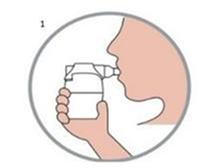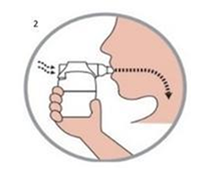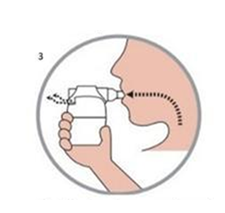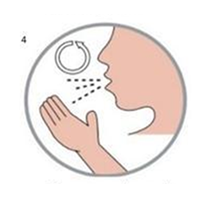- Reference Number: HEY1415/2023
- Departments: Physiotherapy
- Last Updated: 31 August 2023
Introduction
This leaflet has been produced to provide instructions on how to effectively clear your chest using the Aerobika secretion clearance device. Most of your questions should be answered by this leaflet. It is not intended to replace the discussion between you and your physiotherapist, but may act as a starting point for discussion.
If after reading it you have any concerns or require further explanation, please discuss this with a member of the healthcare team caring for you.
What is the Aerobika?
People with lung problems often produce more phlegm (sputum) than is usual. It is important to remove sputum from your lungs to help you breathe easier, reduce coughing and prevent chest infections.
The AEROBIKA Oscillating Positive Expiratory Pressure (OPEP) device is a drug-free and easy to use device designed to aid in the loosening and removal of sputum build up in the lungs.
How to use the Aerobika

- Put the mouthpiece in your mouth and make a tight seal with your lips.
Make sure the resistance is set correctly. This can be adjusted moving the indicator to the plus or minus symbol on the front of the device.

- Breathe in through the device taking a deeper breath than normal, but do not totally fill your lungs.

- Breathe out actively, but not forcefully, through the device. Ideally Keep your cheeks flat and firm to maximize treatment effectiveness.
Looking in a mirror whilst doing this can help you achieve a better technique
Breathing out should last 3 to 4 times longer than breathing in. For example, if breathing in takes 2 seconds then breathing out should last at least 6 seconds.

- Repeat and use a ”huff” as indicated.
Your Physiotherapist will instruct you on how many times this should be completed
Cleaning your Aerobika
This device breaks up easily in to four pieces.
These can be cleaned using:
- Warm water and soap, rinse and air dry.
- Dishwater, top shelf only.
- Boiling water.
- Microwave steam bag.
1. PRESS tabs to release –

2. REMOVE valve cartridge and mouthpiece

3. SOAK 15 minutes in soapy water, agitate gently and rinse
4. SHAKE out water and dry vertically OR PLACE IN DISHWASHER basket on top rack after performing cleaning instructions in numbers 1 and 2 above.
5. REASSEMBLE device

Should you require further advice on the issues contained in this leaflet, please do not hesitate to contact the Bronchiectasis/Cycstic Fibrosis Department on tel: 01482 622 495
General Advice and Consent
Most of your questions should have been answered by this leaflet, but remember that this is only a starting point for discussion with the healthcare team.
Consent to treatment
Before any doctor, nurse or therapist examines or treats you, they must seek your consent or permission. In order to make a decision, you need to have information from health professionals about the treatment or investigation which is being offered to you. You should always ask them more questions if you do not understand or if you want more information.
The information you receive should be about your condition, the alternatives available to you, and whether it carries risks as well as the benefits. What is important is that your consent is genuine or valid. That means:
- you must be able to give your consent
- you must be given enough information to enable you to make a decision
- you must be acting under your own free will and not under the strong influence of another person
Information about you
We collect and use your information to provide you with care and treatment. As part of your care, information about you will be shared between members of a healthcare team, some of whom you may not meet. Your information may also be used to help train staff, to check the quality of our care, to manage and plan the health service, and to help with research. Wherever possible we use anonymous data.
We may pass on relevant information to other health organisations that provide you with care. All information is treated as strictly confidential and is not given to anyone who does not need it. If you have any concerns please ask your doctor, or the person caring for you.
Under the General Data Protection Regulation and the Data Protection Act 2018 we are responsible for maintaining the confidentiality of any information we hold about you. For further information visit the following page: Confidential Information about You.
If you or your carer needs information about your health and wellbeing and about your care and treatment in a different format, such as large print, braille or audio, due to disability, impairment or sensory loss, please advise a member of staff and this can be arranged.
